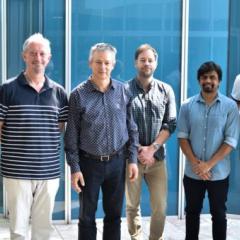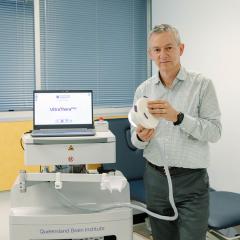Our research integrates experimental, advanced imaging and mathematical modelling approaches to uncover the molecular and systems-level mechanisms driving infectious and neurodegenerative diseases, aiming to engineer new treatment strategies.
Our research focuses on neurodegenerative diseases such as Alzheimer’s disease and frontotemporal dementia, as well as infectious diseases caused by viruses such as SARS-CoV-2 and Zika. Using advanced imaging techniques, such as super-resolution microscopy, alongside biochemical techniques, we investigate the underlying pathomechanisms. We also develop multiscale mathematical models integrating phenomena from molecular to human population levels to understand treatment failures and predict strategies for improving outcomes. The ongoing projects address the following questions:
- What molecular mechanisms underlie synapse and neuronal loss in neurodegenerative diseases?
- Why are only a subset of neurons impacted by pathology, known as selective neuronal vulnerability, in Alzheimer’s disease and other neurodegenerative diseases?
- What role does innate immunity, including interferon and complement signalling, play in the initiation and progression of Alzheimer’s disease?
- Is there a mechanistic link between vaccination, viral infections, and neurodegenerative diseases?
Group leader

Dr Pranesh Padmnabhan
Group Leader, Molecular and Systems Medicine
NHMRC Emerging Leadership Fellow/Senior Research Fellow
+61 7 3346 6341
p.padmanabhan@uq.edu.au
UQ Researcher Profile
Students interested in Honours or PhD programs are encouraged to contact Dr Pranesh Padmanabhan.
We welcome students with experimental or computational backgrounds.
Research areas
- Alzheimer’s disease and tauopathies
- Frontotemporal dementia
- Neuroimmunology
- SARS-CoV2, Zika and other related viral infections
- Advanced microscopy
- Multiscale mathematical modelling
- Quantitative Systems Pharmacology
Research impact
- Identifying nanoscale mechanisms linked with dementia (eLife 2019, Nature Rev Neurosci 2021, EMBO J 2022)
- Advancing super-resolution microscopy tools (J Cell Biol 2016, PNAS 2020)
- Unveiling mechanistic origins of COVID-19 vaccine efficacies (Nature Comput Sci 2022)
- Determining systems-level mechanisms underlying HCV immunotherapy (Nature Commun 2014, PLoS Comput Biol 2018)
- Revealing drug synergy mechanisms and evaluating drug efficacies (CPT: PSP 2015, PNAS 2017, PLoS Comput Biol 2020)
Selected publications
Götz, J., Padmanabhan, P. Ultrasound and antibodies — a potentially powerful combination for Alzheimer disease therapy. Nat Rev Neurol 20, 257–258 (2024). https://doi.org/10.1038/s41582-024-00943-1
Padmanabhan, P., Götz, J. Clinical relevance of animal models in aging-related dementia research. Nat Aging 3, 481–493 (2023). https://doi.org/10.1038/s43587-023-00402-4
Gormal, Rachel S., Padmanabhan, Pranesh, Kasula, Ravikiran, Bademosi, Adekunle T., Coakley, Sean, Giacomotto, Jean, Blum, Ailisa, Joensuu, Merja, Wallis, Tristan P., Lo, Harriet P., Budnar, Srikanth, Rae, James, Ferguson, Charles, Bastiani, Michele, Thomas, Walter G., Pardon, Els, Steyaert, Jan, Yap, Alpha S., Goodhill, Geoffrey J., Hilliard, Massimo A., Parton, Robert G. and Meunier, Frédéric A. (2020). Modular transient nanoclustering of activated β2-adrenergic receptors revealed by single-molecule tracking of conformation-specific nanobodies. Proceedings of the National Academy of Sciences of the United States of America, 117 (48), 30476-30487. doi: 10.1073/pnas.2007443117
Padmanabhan, Pranesh, Kneynsberg, Andrew, Cruz, Esteban, Amor, Rumelo, Sibarita, Jean‐Baptiste and Götz, Jürgen (2022). Single‐molecule imaging reveals Tau trapping at nanometer‐sized dynamic hot spots near the plasma membrane that persists after microtubule perturbation and cholesterol depletion. The EMBO Journal, 41 (19) e111265, 1-16. doi: 10.15252/embj.2022111265
Modeling how antibody responses may determine the efficacy of COVID-19 vaccines
Padmanabhan, Pranesh, Desikan, Rajat and Dixit, Narendra M. (2022). Modeling how antibody responses may determine the efficacy of COVID-19 vaccines. Nature Computational Science, 2 (2), 123-131. doi: 10.1038/s43588-022-00198-0
Super-resolution microscopy: a closer look at synaptic dysfunction in Alzheimer disease
Padmanabhan, Pranesh, Kneynsberg, Andrew and Götz, Jürgen (2021). Super-resolution microscopy: a closer look at synaptic dysfunction in Alzheimer disease. Nature Reviews Neuroscience, 22 (12), 723-740. doi: 10.1038/s41583-021-00531-y
Targeting TMPRSS2 and Cathepsin B/L together may be synergistic against SARS-CoV-2 infection
Padmanabhan, Pranesh, Desikan, Rajat and Dixit, Narendra M. (2020). Targeting TMPRSS2 and Cathepsin B/L together may be synergistic against SARS-CoV-2 infection. PLoS Computational Biology, 16 (12) e1008461, e1008461. doi: 10.1371/journal.pcbi.1008461
Opening of smaller toxin pores by lipid micelle formation
Desikan, Rajat, Padmanabhan, Pranesh and Ganapathy Ayappa, K. (2020). Opening of smaller toxin pores by lipid micelle formation. Proceedings of the National Academy of Sciences of the United States of America, 117 (10), 5107-5108. doi: 10.1073/pnas.1921467117
Padmanabhan, Pranesh, Martínez-Mármol, Ramón, Xia, Di, Götz, Jürgen and Meunier, Frédéric A. (2019). Frontotemporal dementia mutant Tau promotes aberrant Fyn nanoclustering in hippocampal dendritic spines. eLife, 8 e45040. doi: 10.7554/elife.45040
Venugopal, Vishnu, Padmanabhan, Pranesh, Raja, Rubesh and Dixit, Narendra M (2018). Modelling how responsiveness to interferon improves interferon-free treatment of hepatitis C virus infection. PLoS Computational Biology, 14 (7) e1006335, e1006335. doi: 10.1371/journal.pcbi.1006335
Axon growth regulation by a bistable molecular switch
Padmanabhan, Pranesh and Goodhill, Geoffrey J. (2018). Axon growth regulation by a bistable molecular switch. Proceedings of the Royal Society of London B: Biological Sciences, 285 (1877) 20172618, 20172618. doi: 10.1098/rspb.2017.2618
Inhibitors of hepatitis C virus entry may be potent ingredients of optimal drug combinations
Padmanabhan, Pranesh and Dixit, Narendra M. (2017). Inhibitors of hepatitis C virus entry may be potent ingredients of optimal drug combinations. Proceedings of the National Academy of Sciences, 114 (23), E4524-E4526. doi: 10.1073/pnas.1704531114
Padmanabhan, Pranesh, Garaigorta, Urtzi and Dixit, Narendra M. (2014). Emergent properties of the interferon-signalling network may underlie the success of hepatitis C treatment. Nature Communications, 5 (1) 3872, 1-9. doi: 10.1038/ncomms4872
Padmanabhan, Pranesh and Dixit, Narendra M. (2011). Mathematical model of viral kinetics in vitro estimates the number of E2-CD81 complexes necessary for hepatitis C virus entry. PLoS Computational Biology, 7 (12) e1002307, e1002307-e1002307. doi: 10.1371/journal.pcbi.1002307








